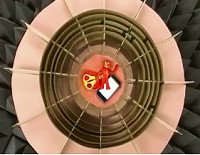Fractal Cloaking Antennas |
|
1 | 2 | 3 | 4 | 5 | 6 | 7 | 8 | 9 | 10 | 11 | 12 | 13 | 14 | 15 | 16 | 17 | 18 | 19 | 20 | 21 | 22 | 23 | 24 | 25 | 26 | 27 | 28 | 29 | 30 | 31 | 32 | 33 | 34 | 35 | 36 | 37
I am not totally convinced that fractals are a necessary part of cloaking, but they do make for interesting publicity photos. After all, if fractals are part of the cloaking equation, then wouldn't fractal-shapes in nature like coastlines and foliage help make them invisible to something noticeable - sound, light, and/or water waves? The magic is probably in the increased projected surface area generated by a fractal's stepped outline. A multitude of similarly dimensioned curved surfaces might actually be better, but curves are broken down into polygons for computer modeling, so that still leaves you analyzing multifaceted flat surfaces.
Fractal Metamaterial Antenna Monopole Demonstration
Fractal Metamaterial Wideband Invisibility Cloak
Fractal Antenna Systems Press Release - December 21, 2010 (Waltham, MA--21 Dec 2010) Can you see it? Researchers at Fractal Antenna Systems have written a new chapter in the science of making things disappears. Their wideband microwave invisibility cloak, first revealed in March 2009, now makes its debut for everyone to see in a new video: https://fractenna.com/whats/whats.html The video conclusively shows that invisibility science has taken a huge leap with fractal design. Fractals are geometric patterns that have complex structure built from scaled repetition of a simple pattern. Fractals make up the cloak and its 'object' layer, producing a wideband invisibility that slipstreams microwaves around obstacles. The other side appears with good fidelity, without the detectable presence of the obstacle. Although a proof-of-concept of an invisibility cloak was shown in 2006 at Duke University, such non-fractal efforts had limitations. The Duke cloak worked in one narrow band, had many more cloaking layers, possessed a discernable shadow, and required the obstacle to already be hiding behind a mirror. All of those obstacles have been solved using fractals, in grids called fractal metamaterial, as the firm's cloak reveals. Holy Grail of Cloak Design Notes the firm's CEO and chief inventor Nathan Cohen: "In 2008, Chinese researchers said it was impossible to make a wideband invisibility cloak. We not only did it, but reduced the number of cloak layers, and, most importantly, made a cloak you can see out of. That means a sensor, for example, can be made to disappear into the background over a wideband, but still be able to see what's outside. These attributes are really the 'holy grail' of cloak designs, and strongly point towards a bright future for invisibility science." The fractal cloak works at microwaves; radio waves used by cell phones and wireless devices. The technology directly applies to infrared, and with technology advances in nanotechnology, can be made to make visual light invisibility cloaks, although Cohen cautions that it will be many years before visual light invisibility cloaks are perfected. "Other researchers are still hiding objects behind mirrors. What's the point of a cloak if you are already hiding behind a mirror?" asked Cohen. The firm's cloak also marks the steady and remarkable process of innovation afforded by fractals in antennas and electronics. Oddly, many American antenna researchers have shied away from fractal design, while interest in Asia and Europe bloomed, noted Cohen. However, as recently shown on PBS's NOVA television program, fractals have a great impact on antennas and electronics, and researchers from all continents except Antarctica now boast many dozens of active research programs. Cohen also believes that success in cloaking science requires a body of diverse knowledge, which in his case drew upon experience as an astronomer, and curiously, as a radio ham operator. "I have a Ph.D. in astrophysics and am a retired college professor. But the experience I gained as a young ham radio operator was invaluable in helping me make knowledge connections to make the cloak work. That's, in part, why my research group did this first, and why we continue to lead in innovation in fractal electronics, both in basic research and application to products." Fractal Antenna Systems, Inc. Fractal Antenna Systems, Inc. (https://www.fractenna.com) supplies products for the world's most demanding wireless, and electromagnetic applications. Backed by over three dozen U.S., and international patents, plus dozens of patents pending, Fractal Antenna Systems is the recognized pioneer in fractal technology, with extensive research and field experience over 15 years in business. The company is a privately held and headquartered in Waltham, Massachusetts, USA. SOURCE: Fractal Antenna Systems,Inc. CONTACT: Jane Winter JWinter@fractenna.com
Posted June 29, 2020 |
 "
"